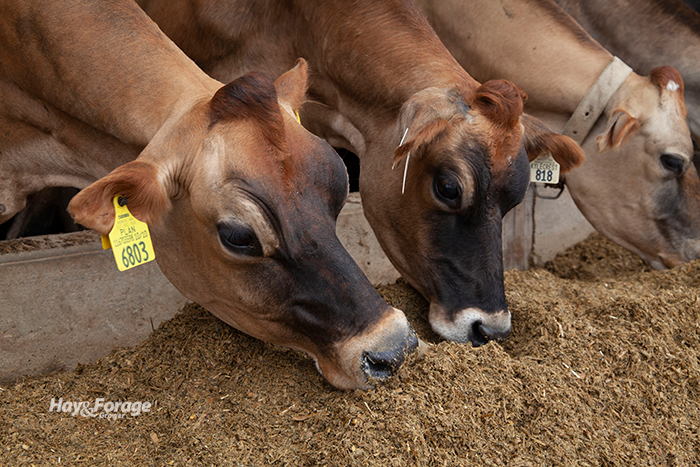
Feeding dairy cattle high-forage diets can improve overall herd health, improve milk component levels, and lower feed costs.
According to Iowa State University’s Gail Carpenter, a 2017 survey of feed industry professionals reported that 91% of operations boosted forage feeding levels in herds during the past 10 to 15 years. “Two reasons for this are home-grown feeds are cost effective and high-forage diets promote the production of milk components,” Carpenter said. “This equals increased income over feed costs.”
According to the assistant professor in dairy production, another reason more people are feeding high-forage diets is because of advances made in plant genetics, forage management, and forage quality.
“There are a lot of benefits to feeding dairy cattle a high-forage diet,” Carpenter said in a recent webinar. “Feeding high-forage diets can improve milk component levels, improve longevity in herds, allow for more voluntary culling, improve income over feed costs, decrease acidosis, cause fewer foot health problems, and lower vet costs.”
The dairy specialist also noted several downsides to feeding high-forage diets to dairy cattle. Forages vary in digestibility based on factors such as maturity, dry matter, drought conditions, and plant genetics. According to Carpenter, a general rule of thumb is that digestibility declines as forage biomass accumulates. Additionally, forages are susceptible to mold and toxins. Forages are less palatable than the concentrates in a mixed diet, so convincing cows to eat them can pose a challenge as well.
Improved rumen health
Carpenter said that high-forage diets are what generally keeps the rumen happy. “If you have a happy rumen, you will have higher milk components, which is what we are focusing on with a high-forage diet,” she said.
To achieve an optimum rumen environment, Carpenter noted that feed management plays a vital role when increasing the forages being fed. Avoid overstocking, as cattle will spend more of their day at the bunk eating forages, allowing the boss cows more time to eat than the submissive ones. If possible, separate first-lactation cows from older cows.
If the weather is hot and lots of fermented forages are being fed, feed more frequently because spoilage can occur quickly. Also, push feed up more often since cattle will spend more time at the bunk eating when they are fed high-forage diets.
Focus on NDF intake
Carpenter said that when talking about high-forage diets, rather than focusing on the percent of the ration that is forage, it’s more useful to assess neutral detergent fiber (NDF) intake. “Generally, a good rule of thumb is that 75% of NDF in a ration is coming from forages and the remainder from concentrates,” she said. “Total NDF intake is going to be limited in most cows at about 1.1% to 1.2% of a cow’s body weight. Field data from farms feeding high-forage diets suggest this can go even higher to 1.4%. Therefore, if 75% of NDF is coming from forage, then 0.9% of a cow’s body weight will come from NDF in the forage.”
Monitor cattle performance
“The keys for success to a high-forage diet boils down to feeding good-quality forage and needing a lot of it,” Carpenter said. “Inventory can be a struggle with a high-forage diet on some farms. When evaluating inventory, consider that the cows will probably eat more when they move to a high-forage diet, so you will need 15% to 30% more forage to account for the increase in dry matter intake.”
To determine whether cows are doing well after incorporating more forages in the diet, Carpenter said the most important aspect to monitor is feed intake, which should be increasing.
Track cow rumination with a rumination monitor or simply check that at least 50% of cows are chewing their cud when resting after eating. Keep an eye on manure consistency and look for any whole corn kernels, which might indicate a processing issue. If there is a lot of fiber in manure, passage rates are likely too high, so consider incorporating something to slow it down. Expect milkfat percentage to stay the same or improve, but if it declines, the cattle are likely sorting the feed or the particle size is too fine.

The author is a freelance writer based in Brookings, S.D., who earned her agricultural communications degree from South Dakota State University. She grew up on a cow-calf operation in Spearfish, S.D, and served as the 2016 editorial intern for Hay & Forage Grower.

